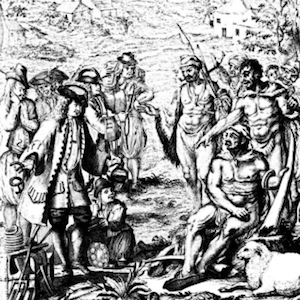Women

Letters of Lady Mary Wortley Montagu
The following are excerpts from the letters of Lady Mary Wortley Montagu (1689-1762), a noted English essayist and one of the earliest advocates of women’s rights.

The Whole Duty of Woman
The following selection comes from a late 17th-century English advice book for women.

Peter Kolb Travel Narrative 2
Peter Kolb was a German astronomer and mathematician who lived at the Cape from 1705 to 1713. He was initially sponsored by a German baron to make astronomical observations in pursuit of a way to calculate longitude accurately.

Journal of Jan van Riebeeck
Krotoa, called Eva by the Dutch, is the first Khoikhoi woman to appear in the European records of the early settlement at the Cape as an individual personality and active participant in cultural and economic exchange.

The Voracious Oath
This fascinating print is modeled on Jacques–Louis David’s Oath of the Horatii. In that famous painting, the artist sought to exemplify patriotic virtue by showing an austere father making his sons swear to defend Roman honor.

A Second Jean d'Arc
To those who considered Marat insincere and dangerous in his unrelenting populism, the true martyr was Charlotte Corday, who had come to Paris from Caen—a city then serving as a base for the federalist insurgency—apparently with the express intent of killing Marat.

Margaret Mead, Coming of Age in Samoa
In 1928, Martha Mead published Coming of Age in Samoa, an anthropological work based on field work she had conducted on female adolescents in Samoa.

Carrying Native-American Babies
This watercolor (fig. 1) of a mother carrying her baby was painted c. 1585 by John White who explored the mid-Atlantic region with other Englishmen including Thomas Hariot.

Italian Mother and Baby
"Italian Mother and Baby" appeared in Jacob Riis's How the Other Half Lives: Studies among the Tenements of New York (1890). This image captures the misery of urban poverty as well as the tenacity of life. It is infused with unmistakable sentimentalism and symbolism.

Two Daughters of Akhenaten
The bas-relief, or carved panel, in limestone shows two sisters embracing. They are princesses from the family of Akhenaten, the 18th pharaonic dynasty in ancient Egypt, dated to 1349–1336 BCE.